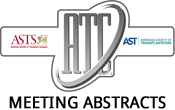2015 American Transplant Congress
Preliminary Results of a Novel Induction Regimen Using Anti-Thymocyte Globulin (Rabbit) (rATG) Plus Basiliximab in a Pediatric Patient Population Undergoing Kidney Transplantation
Purpose: We report the outcomes from single center experience with the novel induction regimen using rATG (3 mg/kg) in divided doses given on operative day…2015 American Transplant Congress
Favorable Long-Term Outcome of Late-Onset CMV Disease in D+R- Kidney Transplant Recipients Treated With Universal Prophylaxis
Based on last international guidelines, both universal prophylaxis and preemptive strategies are viable approaches for the prevention of cytomegalovirus (CMV) disease after organ transplantation. Universal…2015 American Transplant Congress
ABO-Incompatible Live Donor Kidney Transplants Inferior to ABO-Compatible Transplants, but Match Deceased Donor Results: Is Kidney Paired Donation the Answer?
Objective: Compare kidney allograft survival in ABO-incompatible (ABO-I) and ABO-compatible (ABO-C) live donor kidney transplant recipients.Methods: We analyzed UNOS database for patients who underwent a…2015 American Transplant Congress
Microvascular Inflammation in Early Protocol Biopsies of Renal Allografts in Cases of Chronic Active Antibody-Mediated Rejection
Aim:Chronic active antibody-mediated rejection (chronic ABMR) is one important cause of late-stage renal allograft loss. However, few reports have used protocol biopsy to observe changes…2015 American Transplant Congress
Pretransplant Antibodies Against Angiotensin II Type 1 Receptor in Renal Transplantation: Preliminary Data from the KNOW-KT Study
BackgroundThe antibodies (Abs) against angiotensin II type 1 receptor (AT1R) have been suggested as a risk factor for graft failure and acute rejection. However, incidence…2015 American Transplant Congress
Quantifying the Survival Benefit of HLA-Incompatible Kidney Transplantation: A Multi-Center Study
Surgery, Hopkins, Baltimore, MD.
A single center study has demonstrated a two-fold survival benefit of incompatible live donor kidney transplant (ILDKT) compared to remaining on dialysis. We sought to…2015 American Transplant Congress
Umbilical Vein Catheter Versus Double J Stent for Ureteric Anastomosis in Renal Transplantation: A Single Centre, Open Label, Randomized Trial
Transplant Surgery, Manchester Royal Infirmary, Manchester, United Kingdom.
Introduction: Double J (DJ) stents are used routinely in renal transplantation to prevent ureteric complications. A recent Cochrane review of literature showed that routine prophylactic…2015 American Transplant Congress
Propensity Score-Weighted Analysis of Induction Therapies in Live Donor Kidney Transplantation in Modern Immunosuppression Era
1Medicine, UTSW, Dallas, TX; 2Clinical Sciences, UTSW, Dallas, TX; 3Surgery, UTSW, Dallas, TX.
Background: Induction therapy with interleukin-2 receptor antagonist (IL2-RA) is recommended as a first line agent in living donor renal transplantation (LRT). However, use of IL2-RA…2015 American Transplant Congress
Final Results from the BENEFIT-EXT Trial: A 7 Year Follow-Up of Belatacept Treated Patients
Background: At 3 and 5yrs post-transplant, BENEFIT-EXT showed a renal function benefit and consistent safety in belatacept (bela) treated pts vs cyclosporine (CsA). Final 7…2015 American Transplant Congress
The C1q-Binding Assays and Clinical Outcomes in Kidney Transplantation
Background: Contradictory conclusions have emerged from clinical trials when testing the predictive value of C1q-binding donor-specific HLA-antibodies (HLA-DSA). The aim of this study was to…
- « Previous Page
- 1
- …
- 522
- 523
- 524
- 525
- 526
- …
- 531
- Next Page »
